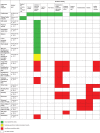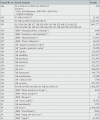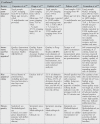Predicting risk and outcomes for frail older adults: an umbrella review of frailty screening tools
- PMID: 28398987
- PMCID: PMC5457829
- DOI: 10.11124/JBISRIR-2016-003018
Predicting risk and outcomes for frail older adults: an umbrella review of frailty screening tools
Abstract
Background: A scoping search identified systematic reviews on diagnostic accuracy and predictive ability of frailty measures in older adults. In most cases, research was confined to specific assessment measures related to a specific clinical model.
Objectives: To summarize the best available evidence from systematic reviews in relation to reliability, validity, diagnostic accuracy and predictive ability of frailty measures in older adults.
Inclusion criteria population: Older adults aged 60 years or older recruited from community, primary care, long-term residential care and hospitals.
Index test: Available frailty measures in older adults.
Reference test: Cardiovascular Health Study phenotype model, the Canadian Study of Health and Aging cumulative deficit model, Comprehensive Geriatric Assessment or other reference tests.
Diagnosis of interest: Frailty defined as an age-related state of decreased physiological reserves characterized by an increased risk of poor clinical outcomes.
Types of studies: Quantitative systematic reviews.
Search strategy: A three-step search strategy was utilized to find systematic reviews, available in English, published between January 2001 and October 2015.
Methodological quality: Assessed by two independent reviewers using the Joanna Briggs Institute critical appraisal checklist for systematic reviews and research synthesis.
Data extraction: Two independent reviewers extracted data using the standardized data extraction tool designed for umbrella reviews.
Data synthesis: Data were only presented in a narrative form due to the heterogeneity of included reviews.
Results: Five reviews with a total of 227,381 participants were included in this umbrella review. Two reviews focused on reliability, validity and diagnostic accuracy; two examined predictive ability for adverse health outcomes; and one investigated validity, diagnostic accuracy and predictive ability. In total, 26 questionnaires and brief assessments and eight frailty indicators were analyzed, most of which were applied to community-dwelling older people. The Frailty Index was examined in almost all these dimensions, with the exception of reliability, and its diagnostic and predictive characteristics were shown to be satisfactory. Gait speed showed high sensitivity, but only moderate specificity, and excellent predictive ability for future disability in activities of daily living. The Tilburg Frailty Indicator was shown to be a reliable and valid measure for frailty screening, but its diagnostic accuracy was not evaluated. Screening Letter, Timed-up-and-go test and PRISMA 7 (Preferred Reporting Items for Systematic Reviews and Meta-Analyses) demonstrated high sensitivity and moderate specificity for identifying frailty. In general, low physical activity, variously measured, was one of the most powerful predictors of future decline in activities of daily living.
Conclusion: Only a few frailty measures seem to be demonstrably valid, reliable and diagnostically accurate, and have good predictive ability. Among them, the Frailty Index and gait speed emerged as the most useful in routine care and community settings. However, none of the included systematic reviews provided responses that met all of our research questions on their own and there is a need for studies that could fill this gap, covering all these issues within the same study. Nevertheless, it was clear that no suitable tool for assessing frailty appropriately in emergency departments was identified.
Conflict of interest statement
There is no conflict of interest in this project.
Figures
References
-
- Rodriguez-Manas L, Feart C, Mann G, Viña J, Chatterji S, Chodzko-Zajko W, et al. Searching for an operational definition of frailty: a Delphi method based consensus statement: the frailty operative definition-consensus conference project. J Gerontol A Biol Sci Med Sci 2013; 68 1:62–67. - PMC - PubMed
-
- Lang PO, Michel JP, Zekry D. Frailty syndrome: a transitional state in a dynamic process. Gerontology 2009; 55 5:539–549. - PubMed
-
- Fried LP, Ferrucci L, Darer J, Williamson JD, Anderson G. Untangling the concepts of disability, frailty, and comorbidity: implications for improved targeting and care. J Gerontol A Biol Sci Med Sci 2004; 59 3:255–263. - PubMed
-
- Rockwood K. What would make a definition of frailty successful? Commentaries. Age and Ageing 2005; 34 5:432–434. - PubMed
-
- Sternberg SA, Schwartz AW, Karunananthan S, Bergman H, Mark Clarfield A. The identification of frailty: a systematic literature review. Prog Geriatr 2011; 59 11:2129–2139. - PubMed
Publication types
MeSH terms
LinkOut - more resources
Full Text Sources
Other Literature Sources
Medical
Research Materials
Miscellaneous























